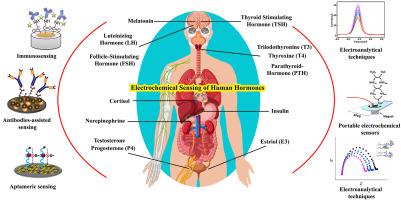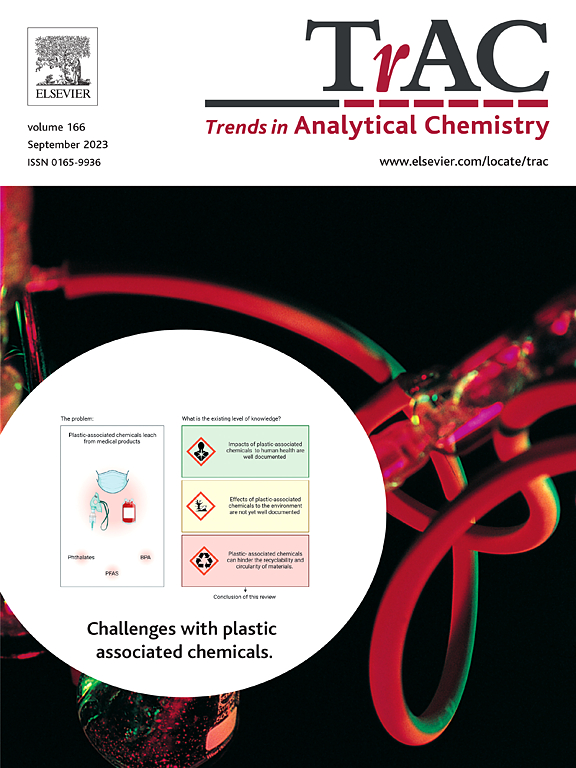Electrochemical sensing of human hormones
IF 12
1区 化学
Q1 CHEMISTRY, ANALYTICAL
引用次数: 0
Abstract
Harmones are vital components of human body since they regulate many biological functions. Therefore, their detection and monitoring is crucial since their imbalance can cause many diseases. Electrochemical sensing is widely used for the detection of human harmones. This review summarizes recent developments in electrochemical sensing for human hormones detection. The strengths and limitations of electrochemical sensing based techniques to detect hormones are discussed. Electrochemical immunosensing of hormones requires biorecognition elements such as antibodies and enzymes. These methods can monitor hormones in standard solutions and real biofluids i.e., serum, plasma, blood, saliva, sweat, and urine. Electrochemical sensors have been developed to many detect hormones such as thyroid stimulating hormone (TSH), thyroxine (T4), triiodothyronine (T3), parathyroid-hormone (PTH), cortisol, follicle-stimulating hormone (FSH), luteinizing hormone (LH), progesterone (P4), testosterone, estriol (E3), melatonin, insulin, norepinephrine, and miscellaneous hormones. The sensing materials, sensing modalities, linearity, stability, limit of detection (LOD), and limit of quantification (LOQ) of fabricated sensors in hormone detection are described. The gaps, bottlenecks, and necessary initiatives in hormone detection are highlighted.

人体荷尔蒙的电化学传感
谐波是人体的重要组成部分,因为它们能调节许多生物功能。因此,对它们的检测和监控至关重要,因为它们的失衡会引发多种疾病。电化学传感被广泛用于人体激素的检测。本综述总结了电化学传感在人体激素检测方面的最新进展。讨论了基于电化学传感技术检测激素的优势和局限性。荷尔蒙的电化学免疫传感需要抗体和酶等生物识别元素。这些方法可以监测标准溶液和实际生物流体(即血清、血浆、血液、唾液、汗液和尿液)中的激素。目前已开发出多种电化学传感器来检测激素,如促甲状腺激素 (TSH)、甲状腺素 (T4)、三碘甲状腺原氨酸 (T3)、甲状旁腺激素 (PTH)、皮质醇、促卵泡激素 (FSH)、黄体生成素 (LH)、孕酮 (P4)、睾酮、雌三醇 (E3)、褪黑激素、胰岛素、去甲肾上腺素和其他激素。介绍了用于激素检测的传感器的传感材料、传感方式、线性度、稳定性、检测限 (LOD) 和定量限 (LOQ)。重点介绍了激素检测方面的差距、瓶颈和必要举措。
本文章由计算机程序翻译,如有差异,请以英文原文为准。
求助全文
约1分钟内获得全文
求助全文
来源期刊

Trends in Analytical Chemistry
化学-分析化学
CiteScore
20.00
自引率
4.60%
发文量
257
审稿时长
3.4 months
期刊介绍:
TrAC publishes succinct and critical overviews of recent advancements in analytical chemistry, designed to assist analytical chemists and other users of analytical techniques. These reviews offer excellent, up-to-date, and timely coverage of various topics within analytical chemistry. Encompassing areas such as analytical instrumentation, biomedical analysis, biomolecular analysis, biosensors, chemical analysis, chemometrics, clinical chemistry, drug discovery, environmental analysis and monitoring, food analysis, forensic science, laboratory automation, materials science, metabolomics, pesticide-residue analysis, pharmaceutical analysis, proteomics, surface science, and water analysis and monitoring, these critical reviews provide comprehensive insights for practitioners in the field.
 求助内容:
求助内容: 应助结果提醒方式:
应助结果提醒方式:


